Regulation Report: Fire Safety, Cyclone & Risk Assessment in Buildings
VerifiedAdded on 2023/06/04
|13
|4193
|50
Report
AI Summary
This report assesses the fire safety and cyclone compliance of a large building, adhering to the Building Code of Australia (BCA) and the Fire Safety regulatory reform order of 2005. A Type A risk assessment was conducted, emphasizing the use of natural resources and occupant knowledge for fire safety. The report details active fire control measures such as emergency lighting, exit signs, smoke detection systems, fire hydrants, and hose reels, all compliant with Australian Standards. It also addresses stair construction, handrails, health and amenity aspects like damp proofing, sanitary facilities, ventilation, and sound insulation. The report considers the climatic conditions of Hamilton Island, recommending materials like brick veneer and timber roofs with cement tiles for optimal insulation. It discusses the productivity and lifespan of building materials, highlighting the need for maintenance and renewable energy sources. The report also covers building material selection, temperature differences inside and outside dwellings, and potential causes of fire incidents, such as window panes.
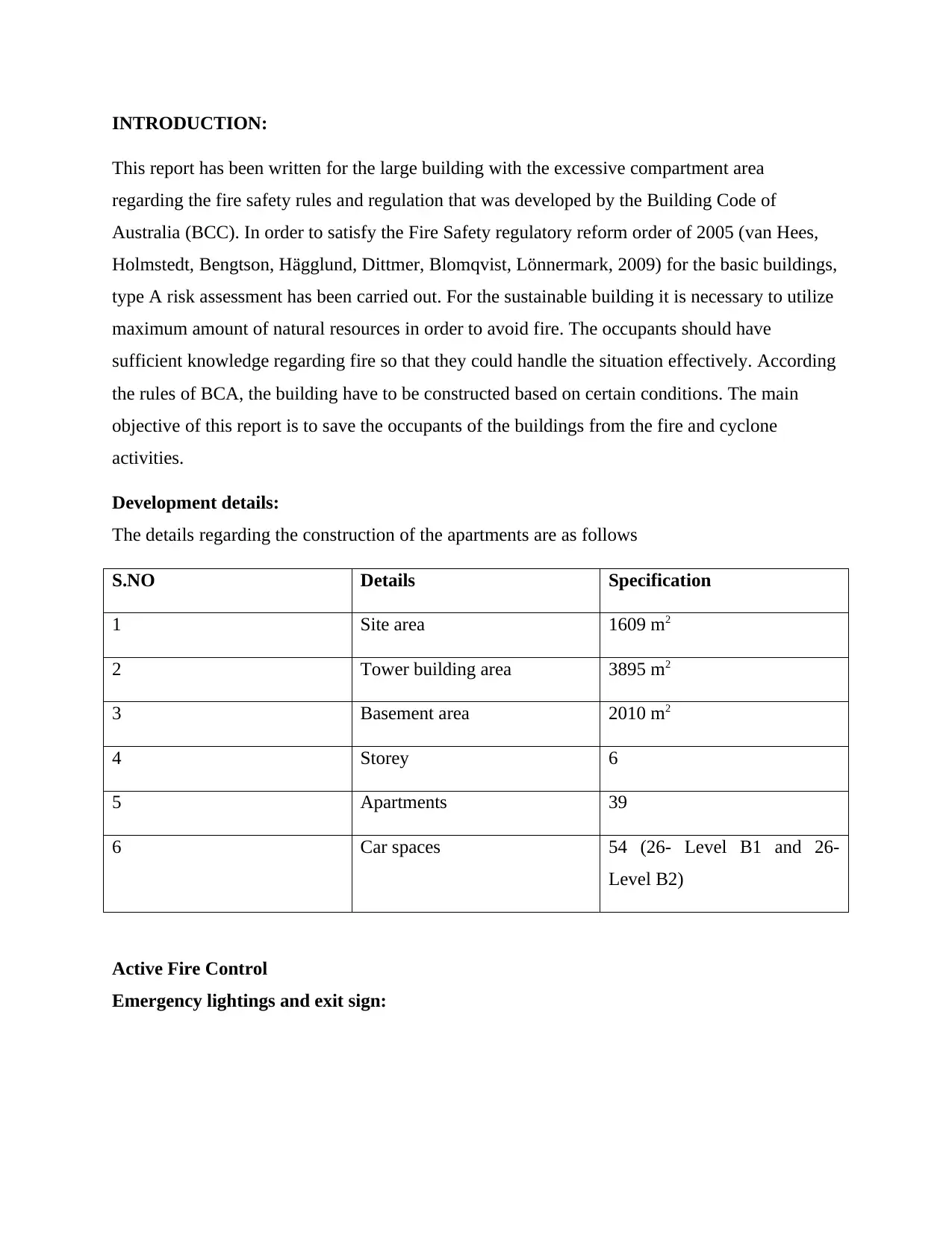
INTRODUCTION:
This report has been written for the large building with the excessive compartment area
regarding the fire safety rules and regulation that was developed by the Building Code of
Australia (BCC). In order to satisfy the Fire Safety regulatory reform order of 2005 (van Hees,
Holmstedt, Bengtson, Hägglund, Dittmer, Blomqvist, Lönnermark, 2009) for the basic buildings,
type A risk assessment has been carried out. For the sustainable building it is necessary to utilize
maximum amount of natural resources in order to avoid fire. The occupants should have
sufficient knowledge regarding fire so that they could handle the situation effectively. According
the rules of BCA, the building have to be constructed based on certain conditions. The main
objective of this report is to save the occupants of the buildings from the fire and cyclone
activities.
Development details:
The details regarding the construction of the apartments are as follows
S.NO Details Specification
1 Site area 1609 m2
2 Tower building area 3895 m2
3 Basement area 2010 m2
4 Storey 6
5 Apartments 39
6 Car spaces 54 (26- Level B1 and 26-
Level B2)
Active Fire Control
Emergency lightings and exit sign:
This report has been written for the large building with the excessive compartment area
regarding the fire safety rules and regulation that was developed by the Building Code of
Australia (BCC). In order to satisfy the Fire Safety regulatory reform order of 2005 (van Hees,
Holmstedt, Bengtson, Hägglund, Dittmer, Blomqvist, Lönnermark, 2009) for the basic buildings,
type A risk assessment has been carried out. For the sustainable building it is necessary to utilize
maximum amount of natural resources in order to avoid fire. The occupants should have
sufficient knowledge regarding fire so that they could handle the situation effectively. According
the rules of BCA, the building have to be constructed based on certain conditions. The main
objective of this report is to save the occupants of the buildings from the fire and cyclone
activities.
Development details:
The details regarding the construction of the apartments are as follows
S.NO Details Specification
1 Site area 1609 m2
2 Tower building area 3895 m2
3 Basement area 2010 m2
4 Storey 6
5 Apartments 39
6 Car spaces 54 (26- Level B1 and 26-
Level B2)
Active Fire Control
Emergency lightings and exit sign:
Paraphrase This Document
Need a fresh take? Get an instant paraphrase of this document with our AI Paraphraser
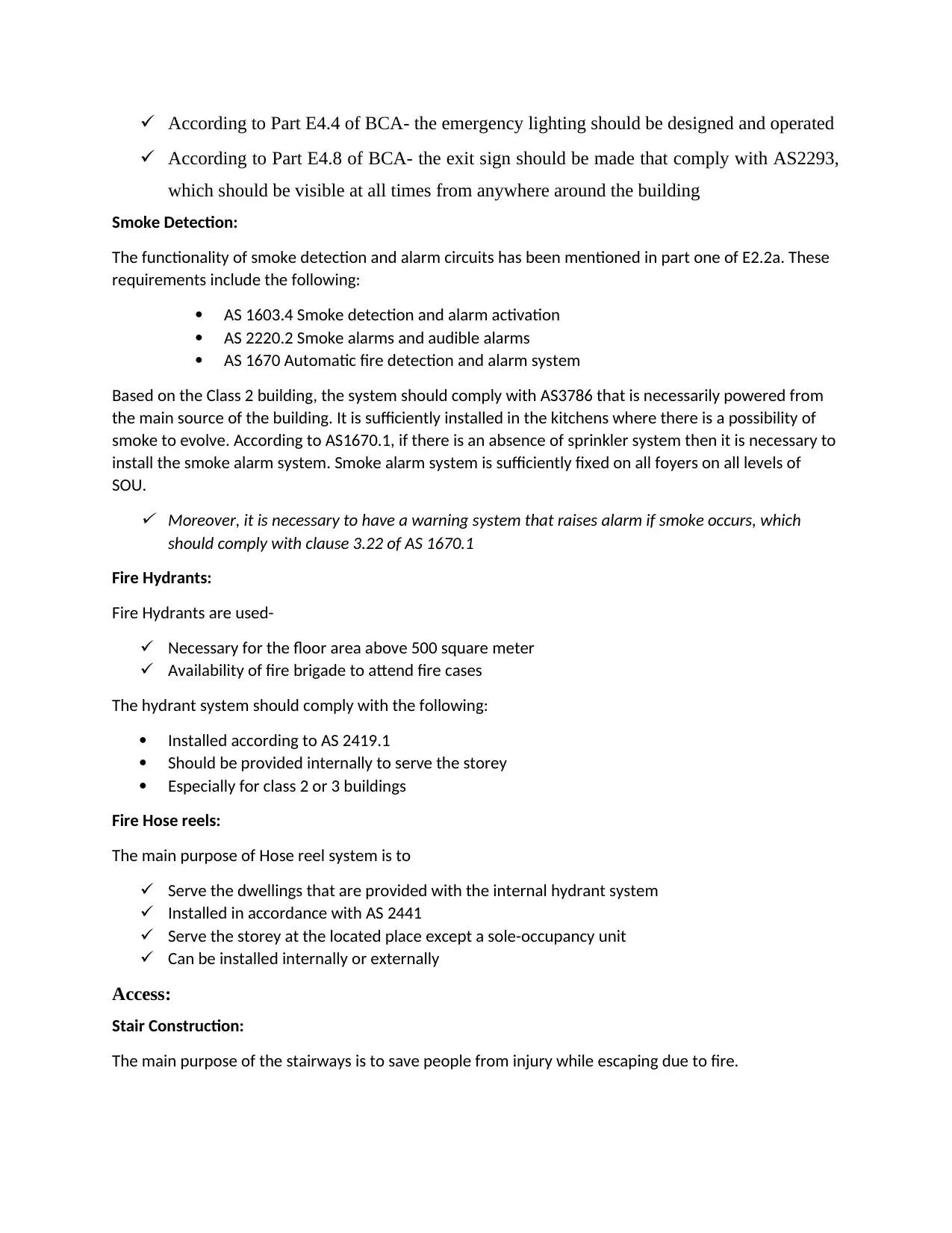
According to Part E4.4 of BCA- the emergency lighting should be designed and operated
According to Part E4.8 of BCA- the exit sign should be made that comply with AS2293,
which should be visible at all times from anywhere around the building
Smoke Detection:
The functionality of smoke detection and alarm circuits has been mentioned in part one of E2.2a. These
requirements include the following:
AS 1603.4 Smoke detection and alarm activation
AS 2220.2 Smoke alarms and audible alarms
AS 1670 Automatic fire detection and alarm system
Based on the Class 2 building, the system should comply with AS3786 that is necessarily powered from
the main source of the building. It is sufficiently installed in the kitchens where there is a possibility of
smoke to evolve. According to AS1670.1, if there is an absence of sprinkler system then it is necessary to
install the smoke alarm system. Smoke alarm system is sufficiently fixed on all foyers on all levels of
SOU. Moreover, it is necessary to have a warning system that raises alarm if smoke occurs, which
should comply with clause 3.22 of AS 1670.1
Fire Hydrants:
Fire Hydrants are used-
Necessary for the floor area above 500 square meter
Availability of fire brigade to attend fire cases
The hydrant system should comply with the following:
Installed according to AS 2419.1
Should be provided internally to serve the storey
Especially for class 2 or 3 buildings
Fire Hose reels:
The main purpose of Hose reel system is to
Serve the dwellings that are provided with the internal hydrant system
Installed in accordance with AS 2441
Serve the storey at the located place except a sole-occupancy unit
Can be installed internally or externally
Access:
Stair Construction:
The main purpose of the stairways is to save people from injury while escaping due to fire.
According to Part E4.8 of BCA- the exit sign should be made that comply with AS2293,
which should be visible at all times from anywhere around the building
Smoke Detection:
The functionality of smoke detection and alarm circuits has been mentioned in part one of E2.2a. These
requirements include the following:
AS 1603.4 Smoke detection and alarm activation
AS 2220.2 Smoke alarms and audible alarms
AS 1670 Automatic fire detection and alarm system
Based on the Class 2 building, the system should comply with AS3786 that is necessarily powered from
the main source of the building. It is sufficiently installed in the kitchens where there is a possibility of
smoke to evolve. According to AS1670.1, if there is an absence of sprinkler system then it is necessary to
install the smoke alarm system. Smoke alarm system is sufficiently fixed on all foyers on all levels of
SOU. Moreover, it is necessary to have a warning system that raises alarm if smoke occurs, which
should comply with clause 3.22 of AS 1670.1
Fire Hydrants:
Fire Hydrants are used-
Necessary for the floor area above 500 square meter
Availability of fire brigade to attend fire cases
The hydrant system should comply with the following:
Installed according to AS 2419.1
Should be provided internally to serve the storey
Especially for class 2 or 3 buildings
Fire Hose reels:
The main purpose of Hose reel system is to
Serve the dwellings that are provided with the internal hydrant system
Installed in accordance with AS 2441
Serve the storey at the located place except a sole-occupancy unit
Can be installed internally or externally
Access:
Stair Construction:
The main purpose of the stairways is to save people from injury while escaping due to fire.
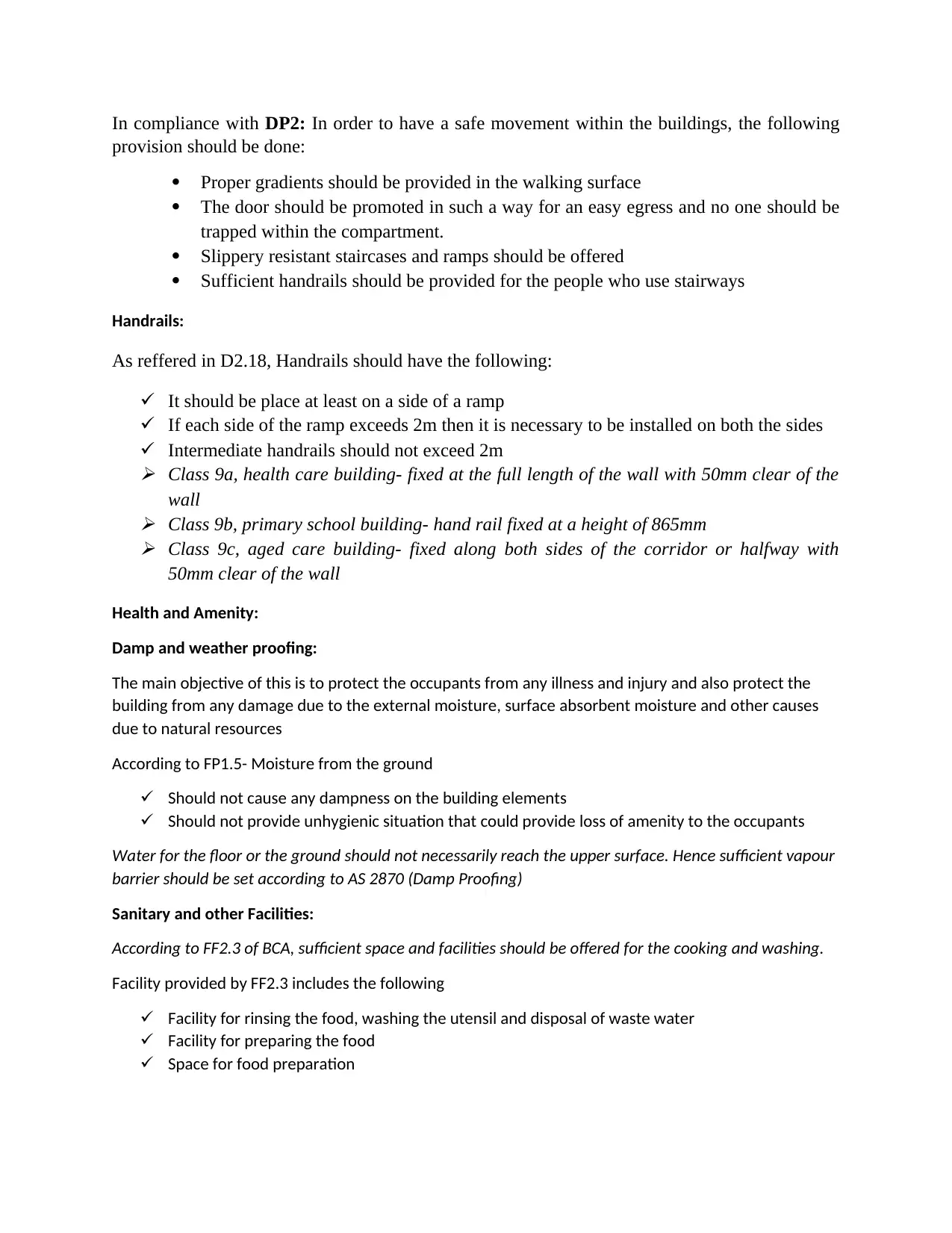
In compliance with DP2: In order to have a safe movement within the buildings, the following
provision should be done:
Proper gradients should be provided in the walking surface
The door should be promoted in such a way for an easy egress and no one should be
trapped within the compartment.
Slippery resistant staircases and ramps should be offered
Sufficient handrails should be provided for the people who use stairways
Handrails:
As reffered in D2.18, Handrails should have the following:
It should be place at least on a side of a ramp
If each side of the ramp exceeds 2m then it is necessary to be installed on both the sides
Intermediate handrails should not exceed 2m
Class 9a, health care building- fixed at the full length of the wall with 50mm clear of the
wall
Class 9b, primary school building- hand rail fixed at a height of 865mm
Class 9c, aged care building- fixed along both sides of the corridor or halfway with
50mm clear of the wall
Health and Amenity:
Damp and weather proofing:
The main objective of this is to protect the occupants from any illness and injury and also protect the
building from any damage due to the external moisture, surface absorbent moisture and other causes
due to natural resources
According to FP1.5- Moisture from the ground
Should not cause any dampness on the building elements
Should not provide unhygienic situation that could provide loss of amenity to the occupants
Water for the floor or the ground should not necessarily reach the upper surface. Hence sufficient vapour
barrier should be set according to AS 2870 (Damp Proofing)
Sanitary and other Facilities:
According to FF2.3 of BCA, sufficient space and facilities should be offered for the cooking and washing.
Facility provided by FF2.3 includes the following
Facility for rinsing the food, washing the utensil and disposal of waste water
Facility for preparing the food
Space for food preparation
provision should be done:
Proper gradients should be provided in the walking surface
The door should be promoted in such a way for an easy egress and no one should be
trapped within the compartment.
Slippery resistant staircases and ramps should be offered
Sufficient handrails should be provided for the people who use stairways
Handrails:
As reffered in D2.18, Handrails should have the following:
It should be place at least on a side of a ramp
If each side of the ramp exceeds 2m then it is necessary to be installed on both the sides
Intermediate handrails should not exceed 2m
Class 9a, health care building- fixed at the full length of the wall with 50mm clear of the
wall
Class 9b, primary school building- hand rail fixed at a height of 865mm
Class 9c, aged care building- fixed along both sides of the corridor or halfway with
50mm clear of the wall
Health and Amenity:
Damp and weather proofing:
The main objective of this is to protect the occupants from any illness and injury and also protect the
building from any damage due to the external moisture, surface absorbent moisture and other causes
due to natural resources
According to FP1.5- Moisture from the ground
Should not cause any dampness on the building elements
Should not provide unhygienic situation that could provide loss of amenity to the occupants
Water for the floor or the ground should not necessarily reach the upper surface. Hence sufficient vapour
barrier should be set according to AS 2870 (Damp Proofing)
Sanitary and other Facilities:
According to FF2.3 of BCA, sufficient space and facilities should be offered for the cooking and washing.
Facility provided by FF2.3 includes the following
Facility for rinsing the food, washing the utensil and disposal of waste water
Facility for preparing the food
Space for food preparation
⊘ This is a preview!⊘
Do you want full access?
Subscribe today to unlock all pages.

Trusted by 1+ million students worldwide
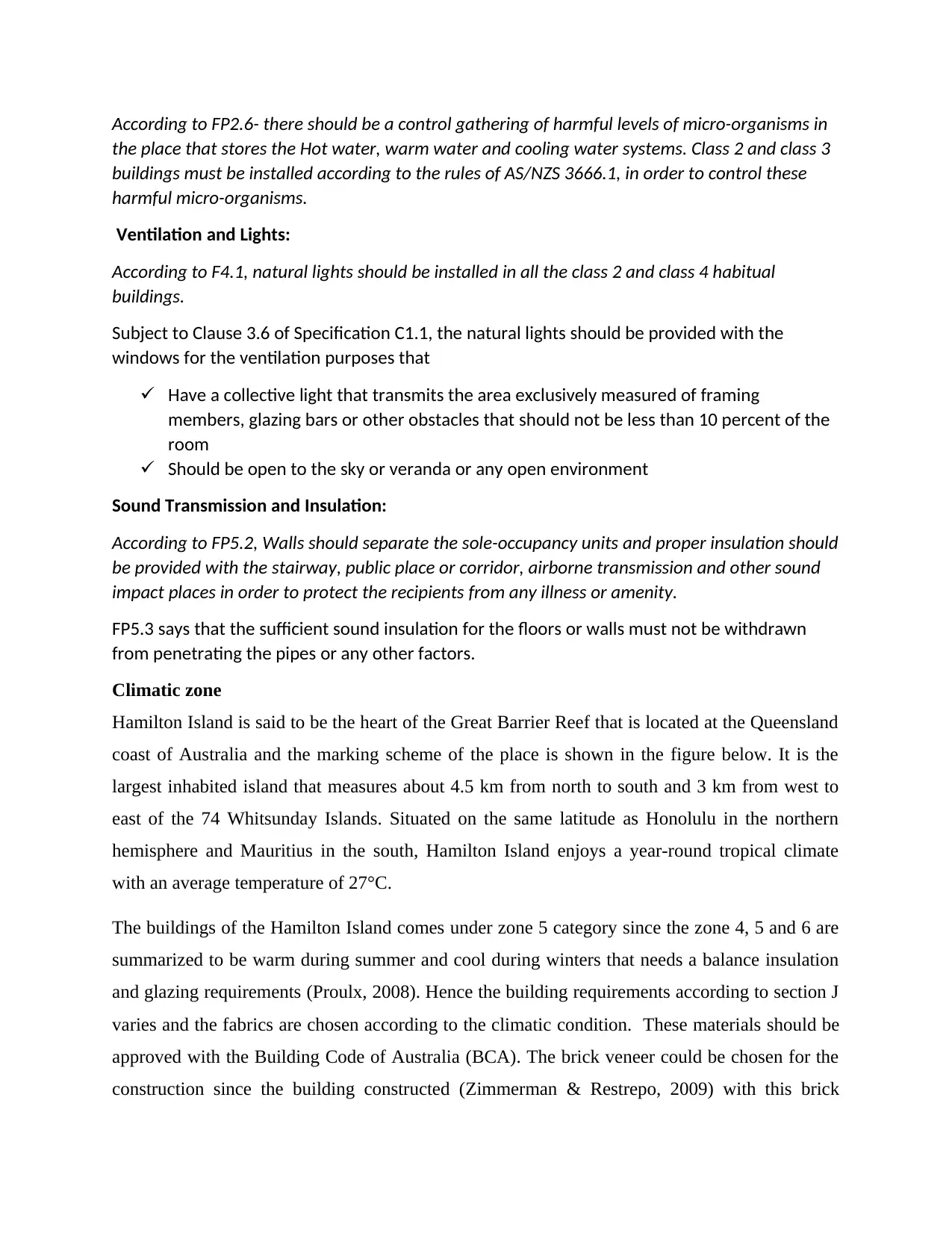
According to FP2.6- there should be a control gathering of harmful levels of micro-organisms in
the place that stores the Hot water, warm water and cooling water systems. Class 2 and class 3
buildings must be installed according to the rules of AS/NZS 3666.1, in order to control these
harmful micro-organisms.
Ventilation and Lights:
According to F4.1, natural lights should be installed in all the class 2 and class 4 habitual
buildings.
Subject to Clause 3.6 of Specification C1.1, the natural lights should be provided with the
windows for the ventilation purposes that
Have a collective light that transmits the area exclusively measured of framing
members, glazing bars or other obstacles that should not be less than 10 percent of the
room
Should be open to the sky or veranda or any open environment
Sound Transmission and Insulation:
According to FP5.2, Walls should separate the sole-occupancy units and proper insulation should
be provided with the stairway, public place or corridor, airborne transmission and other sound
impact places in order to protect the recipients from any illness or amenity.
FP5.3 says that the sufficient sound insulation for the floors or walls must not be withdrawn
from penetrating the pipes or any other factors.
Climatic zone
Hamilton Island is said to be the heart of the Great Barrier Reef that is located at the Queensland
coast of Australia and the marking scheme of the place is shown in the figure below. It is the
largest inhabited island that measures about 4.5 km from north to south and 3 km from west to
east of the 74 Whitsunday Islands. Situated on the same latitude as Honolulu in the northern
hemisphere and Mauritius in the south, Hamilton Island enjoys a year-round tropical climate
with an average temperature of 27°C.
The buildings of the Hamilton Island comes under zone 5 category since the zone 4, 5 and 6 are
summarized to be warm during summer and cool during winters that needs a balance insulation
and glazing requirements (Proulx, 2008). Hence the building requirements according to section J
varies and the fabrics are chosen according to the climatic condition. These materials should be
approved with the Building Code of Australia (BCA). The brick veneer could be chosen for the
construction since the building constructed (Zimmerman & Restrepo, 2009) with this brick
the place that stores the Hot water, warm water and cooling water systems. Class 2 and class 3
buildings must be installed according to the rules of AS/NZS 3666.1, in order to control these
harmful micro-organisms.
Ventilation and Lights:
According to F4.1, natural lights should be installed in all the class 2 and class 4 habitual
buildings.
Subject to Clause 3.6 of Specification C1.1, the natural lights should be provided with the
windows for the ventilation purposes that
Have a collective light that transmits the area exclusively measured of framing
members, glazing bars or other obstacles that should not be less than 10 percent of the
room
Should be open to the sky or veranda or any open environment
Sound Transmission and Insulation:
According to FP5.2, Walls should separate the sole-occupancy units and proper insulation should
be provided with the stairway, public place or corridor, airborne transmission and other sound
impact places in order to protect the recipients from any illness or amenity.
FP5.3 says that the sufficient sound insulation for the floors or walls must not be withdrawn
from penetrating the pipes or any other factors.
Climatic zone
Hamilton Island is said to be the heart of the Great Barrier Reef that is located at the Queensland
coast of Australia and the marking scheme of the place is shown in the figure below. It is the
largest inhabited island that measures about 4.5 km from north to south and 3 km from west to
east of the 74 Whitsunday Islands. Situated on the same latitude as Honolulu in the northern
hemisphere and Mauritius in the south, Hamilton Island enjoys a year-round tropical climate
with an average temperature of 27°C.
The buildings of the Hamilton Island comes under zone 5 category since the zone 4, 5 and 6 are
summarized to be warm during summer and cool during winters that needs a balance insulation
and glazing requirements (Proulx, 2008). Hence the building requirements according to section J
varies and the fabrics are chosen according to the climatic condition. These materials should be
approved with the Building Code of Australia (BCA). The brick veneer could be chosen for the
construction since the building constructed (Zimmerman & Restrepo, 2009) with this brick
Paraphrase This Document
Need a fresh take? Get an instant paraphrase of this document with our AI Paraphraser
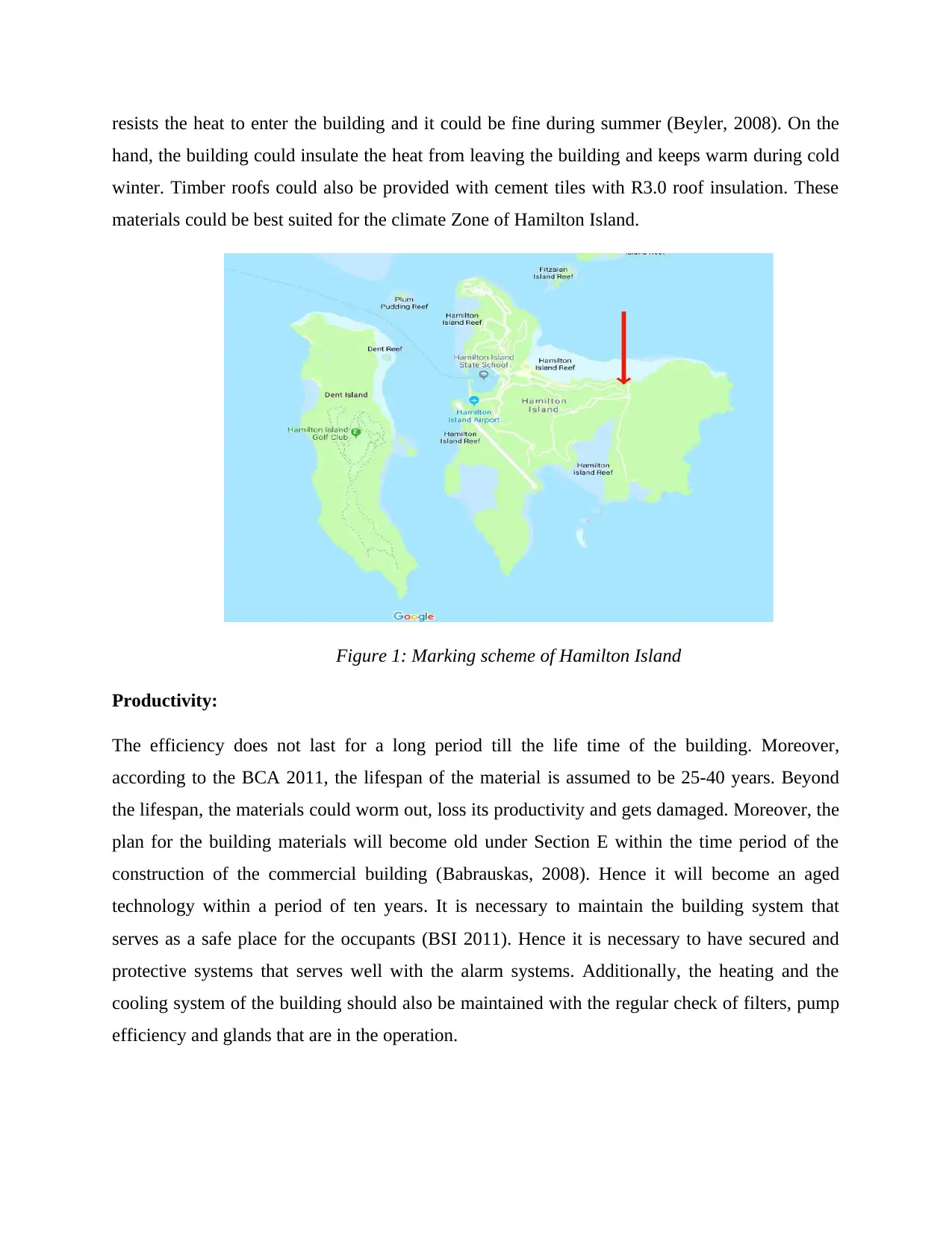
resists the heat to enter the building and it could be fine during summer (Beyler, 2008). On the
hand, the building could insulate the heat from leaving the building and keeps warm during cold
winter. Timber roofs could also be provided with cement tiles with R3.0 roof insulation. These
materials could be best suited for the climate Zone of Hamilton Island.
Figure 1: Marking scheme of Hamilton Island
Productivity:
The efficiency does not last for a long period till the life time of the building. Moreover,
according to the BCA 2011, the lifespan of the material is assumed to be 25-40 years. Beyond
the lifespan, the materials could worm out, loss its productivity and gets damaged. Moreover, the
plan for the building materials will become old under Section E within the time period of the
construction of the commercial building (Babrauskas, 2008). Hence it will become an aged
technology within a period of ten years. It is necessary to maintain the building system that
serves as a safe place for the occupants (BSI 2011). Hence it is necessary to have secured and
protective systems that serves well with the alarm systems. Additionally, the heating and the
cooling system of the building should also be maintained with the regular check of filters, pump
efficiency and glands that are in the operation.
hand, the building could insulate the heat from leaving the building and keeps warm during cold
winter. Timber roofs could also be provided with cement tiles with R3.0 roof insulation. These
materials could be best suited for the climate Zone of Hamilton Island.
Figure 1: Marking scheme of Hamilton Island
Productivity:
The efficiency does not last for a long period till the life time of the building. Moreover,
according to the BCA 2011, the lifespan of the material is assumed to be 25-40 years. Beyond
the lifespan, the materials could worm out, loss its productivity and gets damaged. Moreover, the
plan for the building materials will become old under Section E within the time period of the
construction of the commercial building (Babrauskas, 2008). Hence it will become an aged
technology within a period of ten years. It is necessary to maintain the building system that
serves as a safe place for the occupants (BSI 2011). Hence it is necessary to have secured and
protective systems that serves well with the alarm systems. Additionally, the heating and the
cooling system of the building should also be maintained with the regular check of filters, pump
efficiency and glands that are in the operation.
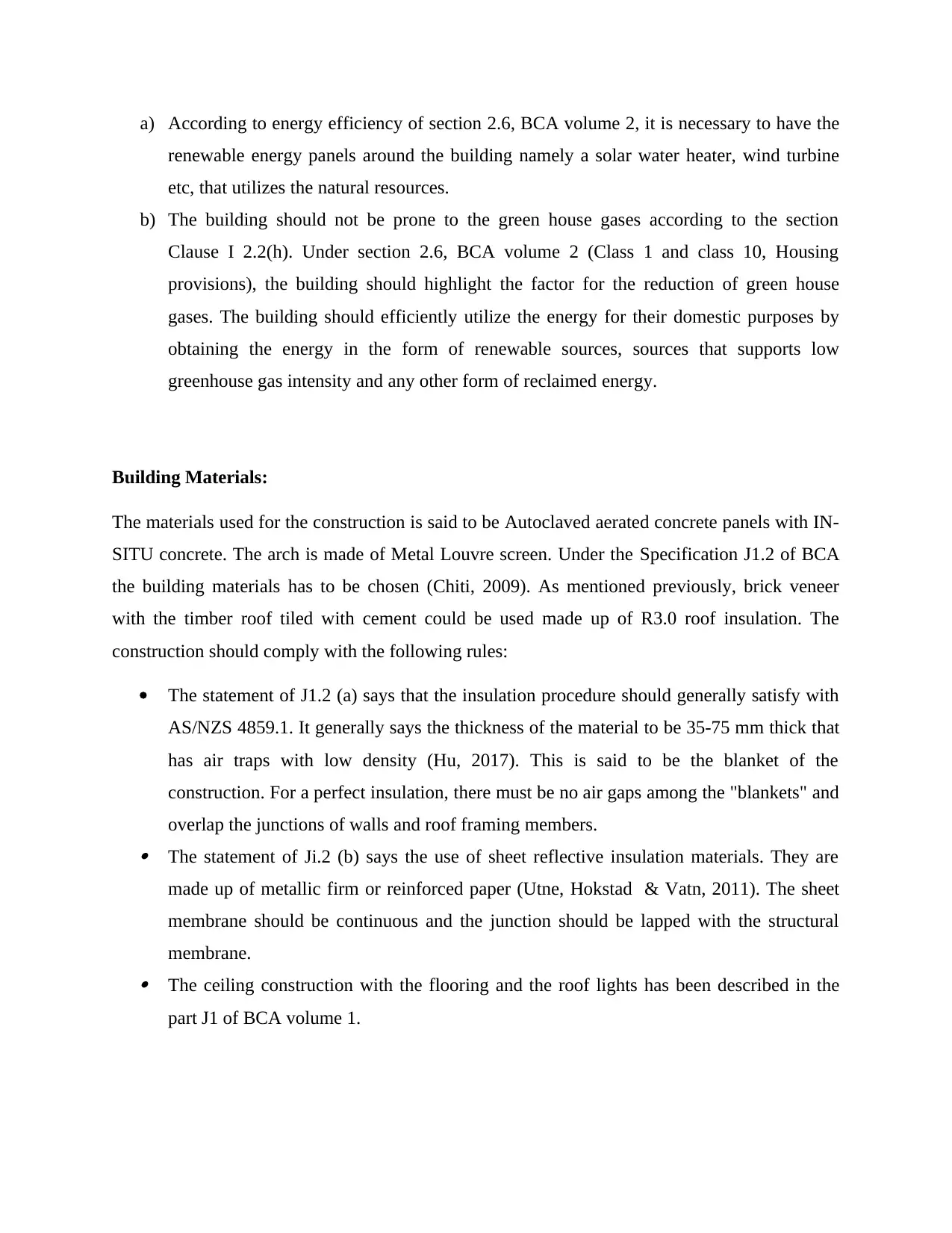
a) According to energy efficiency of section 2.6, BCA volume 2, it is necessary to have the
renewable energy panels around the building namely a solar water heater, wind turbine
etc, that utilizes the natural resources.
b) The building should not be prone to the green house gases according to the section
Clause I 2.2(h). Under section 2.6, BCA volume 2 (Class 1 and class 10, Housing
provisions), the building should highlight the factor for the reduction of green house
gases. The building should efficiently utilize the energy for their domestic purposes by
obtaining the energy in the form of renewable sources, sources that supports low
greenhouse gas intensity and any other form of reclaimed energy.
Building Materials:
The materials used for the construction is said to be Autoclaved aerated concrete panels with IN-
SITU concrete. The arch is made of Metal Louvre screen. Under the Specification J1.2 of BCA
the building materials has to be chosen (Chiti, 2009). As mentioned previously, brick veneer
with the timber roof tiled with cement could be used made up of R3.0 roof insulation. The
construction should comply with the following rules:
The statement of J1.2 (a) says that the insulation procedure should generally satisfy with
AS/NZS 4859.1. It generally says the thickness of the material to be 35-75 mm thick that
has air traps with low density (Hu, 2017). This is said to be the blanket of the
construction. For a perfect insulation, there must be no air gaps among the "blankets" and
overlap the junctions of walls and roof framing members. The statement of Ji.2 (b) says the use of sheet reflective insulation materials. They are
made up of metallic firm or reinforced paper (Utne, Hokstad & Vatn, 2011). The sheet
membrane should be continuous and the junction should be lapped with the structural
membrane. The ceiling construction with the flooring and the roof lights has been described in the
part J1 of BCA volume 1.
renewable energy panels around the building namely a solar water heater, wind turbine
etc, that utilizes the natural resources.
b) The building should not be prone to the green house gases according to the section
Clause I 2.2(h). Under section 2.6, BCA volume 2 (Class 1 and class 10, Housing
provisions), the building should highlight the factor for the reduction of green house
gases. The building should efficiently utilize the energy for their domestic purposes by
obtaining the energy in the form of renewable sources, sources that supports low
greenhouse gas intensity and any other form of reclaimed energy.
Building Materials:
The materials used for the construction is said to be Autoclaved aerated concrete panels with IN-
SITU concrete. The arch is made of Metal Louvre screen. Under the Specification J1.2 of BCA
the building materials has to be chosen (Chiti, 2009). As mentioned previously, brick veneer
with the timber roof tiled with cement could be used made up of R3.0 roof insulation. The
construction should comply with the following rules:
The statement of J1.2 (a) says that the insulation procedure should generally satisfy with
AS/NZS 4859.1. It generally says the thickness of the material to be 35-75 mm thick that
has air traps with low density (Hu, 2017). This is said to be the blanket of the
construction. For a perfect insulation, there must be no air gaps among the "blankets" and
overlap the junctions of walls and roof framing members. The statement of Ji.2 (b) says the use of sheet reflective insulation materials. They are
made up of metallic firm or reinforced paper (Utne, Hokstad & Vatn, 2011). The sheet
membrane should be continuous and the junction should be lapped with the structural
membrane. The ceiling construction with the flooring and the roof lights has been described in the
part J1 of BCA volume 1.
⊘ This is a preview!⊘
Do you want full access?
Subscribe today to unlock all pages.

Trusted by 1+ million students worldwide
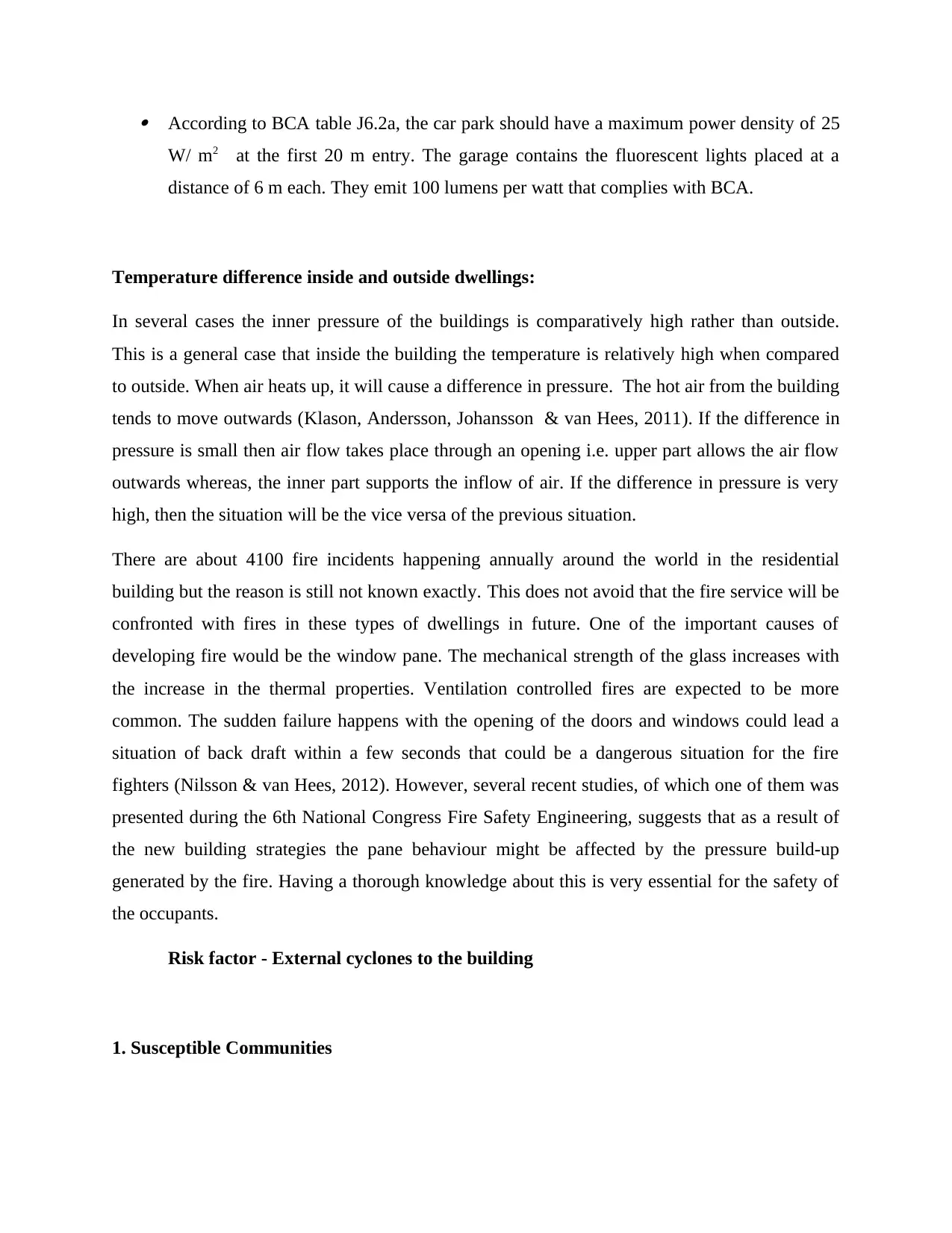
According to BCA table J6.2a, the car park should have a maximum power density of 25
W/ m2 at the first 20 m entry. The garage contains the fluorescent lights placed at a
distance of 6 m each. They emit 100 lumens per watt that complies with BCA.
Temperature difference inside and outside dwellings:
In several cases the inner pressure of the buildings is comparatively high rather than outside.
This is a general case that inside the building the temperature is relatively high when compared
to outside. When air heats up, it will cause a difference in pressure. The hot air from the building
tends to move outwards (Klason, Andersson, Johansson & van Hees, 2011). If the difference in
pressure is small then air flow takes place through an opening i.e. upper part allows the air flow
outwards whereas, the inner part supports the inflow of air. If the difference in pressure is very
high, then the situation will be the vice versa of the previous situation.
There are about 4100 fire incidents happening annually around the world in the residential
building but the reason is still not known exactly. This does not avoid that the fire service will be
confronted with fires in these types of dwellings in future. One of the important causes of
developing fire would be the window pane. The mechanical strength of the glass increases with
the increase in the thermal properties. Ventilation controlled fires are expected to be more
common. The sudden failure happens with the opening of the doors and windows could lead a
situation of back draft within a few seconds that could be a dangerous situation for the fire
fighters (Nilsson & van Hees, 2012). However, several recent studies, of which one of them was
presented during the 6th National Congress Fire Safety Engineering, suggests that as a result of
the new building strategies the pane behaviour might be affected by the pressure build-up
generated by the fire. Having a thorough knowledge about this is very essential for the safety of
the occupants.
Risk factor - External cyclones to the building
1. Susceptible Communities
W/ m2 at the first 20 m entry. The garage contains the fluorescent lights placed at a
distance of 6 m each. They emit 100 lumens per watt that complies with BCA.
Temperature difference inside and outside dwellings:
In several cases the inner pressure of the buildings is comparatively high rather than outside.
This is a general case that inside the building the temperature is relatively high when compared
to outside. When air heats up, it will cause a difference in pressure. The hot air from the building
tends to move outwards (Klason, Andersson, Johansson & van Hees, 2011). If the difference in
pressure is small then air flow takes place through an opening i.e. upper part allows the air flow
outwards whereas, the inner part supports the inflow of air. If the difference in pressure is very
high, then the situation will be the vice versa of the previous situation.
There are about 4100 fire incidents happening annually around the world in the residential
building but the reason is still not known exactly. This does not avoid that the fire service will be
confronted with fires in these types of dwellings in future. One of the important causes of
developing fire would be the window pane. The mechanical strength of the glass increases with
the increase in the thermal properties. Ventilation controlled fires are expected to be more
common. The sudden failure happens with the opening of the doors and windows could lead a
situation of back draft within a few seconds that could be a dangerous situation for the fire
fighters (Nilsson & van Hees, 2012). However, several recent studies, of which one of them was
presented during the 6th National Congress Fire Safety Engineering, suggests that as a result of
the new building strategies the pane behaviour might be affected by the pressure build-up
generated by the fire. Having a thorough knowledge about this is very essential for the safety of
the occupants.
Risk factor - External cyclones to the building
1. Susceptible Communities
Paraphrase This Document
Need a fresh take? Get an instant paraphrase of this document with our AI Paraphraser
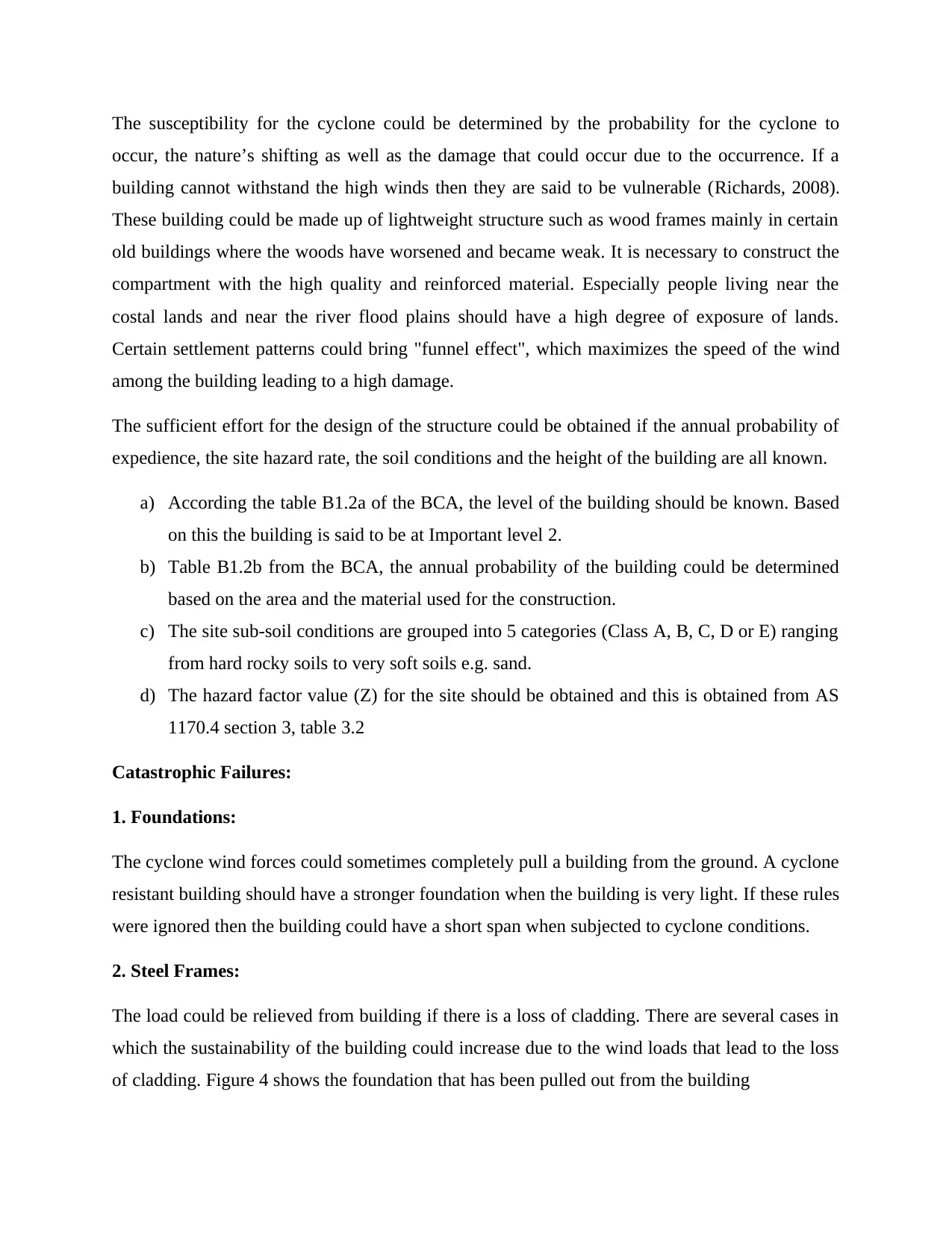
The susceptibility for the cyclone could be determined by the probability for the cyclone to
occur, the nature’s shifting as well as the damage that could occur due to the occurrence. If a
building cannot withstand the high winds then they are said to be vulnerable (Richards, 2008).
These building could be made up of lightweight structure such as wood frames mainly in certain
old buildings where the woods have worsened and became weak. It is necessary to construct the
compartment with the high quality and reinforced material. Especially people living near the
costal lands and near the river flood plains should have a high degree of exposure of lands.
Certain settlement patterns could bring "funnel effect", which maximizes the speed of the wind
among the building leading to a high damage.
The sufficient effort for the design of the structure could be obtained if the annual probability of
expedience, the site hazard rate, the soil conditions and the height of the building are all known.
a) According the table B1.2a of the BCA, the level of the building should be known. Based
on this the building is said to be at Important level 2.
b) Table B1.2b from the BCA, the annual probability of the building could be determined
based on the area and the material used for the construction.
c) The site sub-soil conditions are grouped into 5 categories (Class A, B, C, D or E) ranging
from hard rocky soils to very soft soils e.g. sand.
d) The hazard factor value (Z) for the site should be obtained and this is obtained from AS
1170.4 section 3, table 3.2
Catastrophic Failures:
1. Foundations:
The cyclone wind forces could sometimes completely pull a building from the ground. A cyclone
resistant building should have a stronger foundation when the building is very light. If these rules
were ignored then the building could have a short span when subjected to cyclone conditions.
2. Steel Frames:
The load could be relieved from building if there is a loss of cladding. There are several cases in
which the sustainability of the building could increase due to the wind loads that lead to the loss
of cladding. Figure 4 shows the foundation that has been pulled out from the building
occur, the nature’s shifting as well as the damage that could occur due to the occurrence. If a
building cannot withstand the high winds then they are said to be vulnerable (Richards, 2008).
These building could be made up of lightweight structure such as wood frames mainly in certain
old buildings where the woods have worsened and became weak. It is necessary to construct the
compartment with the high quality and reinforced material. Especially people living near the
costal lands and near the river flood plains should have a high degree of exposure of lands.
Certain settlement patterns could bring "funnel effect", which maximizes the speed of the wind
among the building leading to a high damage.
The sufficient effort for the design of the structure could be obtained if the annual probability of
expedience, the site hazard rate, the soil conditions and the height of the building are all known.
a) According the table B1.2a of the BCA, the level of the building should be known. Based
on this the building is said to be at Important level 2.
b) Table B1.2b from the BCA, the annual probability of the building could be determined
based on the area and the material used for the construction.
c) The site sub-soil conditions are grouped into 5 categories (Class A, B, C, D or E) ranging
from hard rocky soils to very soft soils e.g. sand.
d) The hazard factor value (Z) for the site should be obtained and this is obtained from AS
1170.4 section 3, table 3.2
Catastrophic Failures:
1. Foundations:
The cyclone wind forces could sometimes completely pull a building from the ground. A cyclone
resistant building should have a stronger foundation when the building is very light. If these rules
were ignored then the building could have a short span when subjected to cyclone conditions.
2. Steel Frames:
The load could be relieved from building if there is a loss of cladding. There are several cases in
which the sustainability of the building could increase due to the wind loads that lead to the loss
of cladding. Figure 4 shows the foundation that has been pulled out from the building
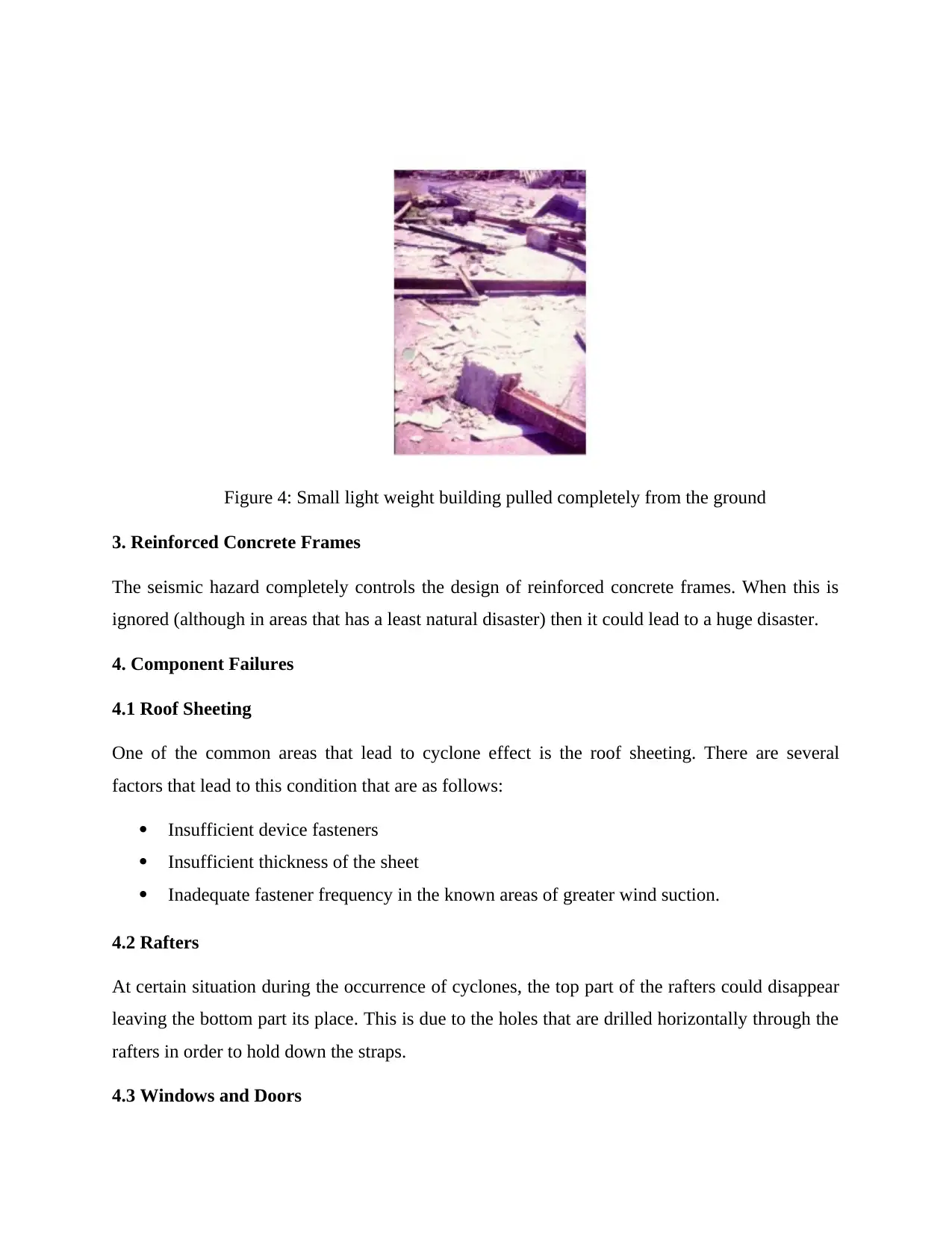
Figure 4: Small light weight building pulled completely from the ground
3. Reinforced Concrete Frames
The seismic hazard completely controls the design of reinforced concrete frames. When this is
ignored (although in areas that has a least natural disaster) then it could lead to a huge disaster.
4. Component Failures
4.1 Roof Sheeting
One of the common areas that lead to cyclone effect is the roof sheeting. There are several
factors that lead to this condition that are as follows:
Insufficient device fasteners
Insufficient thickness of the sheet
Inadequate fastener frequency in the known areas of greater wind suction.
4.2 Rafters
At certain situation during the occurrence of cyclones, the top part of the rafters could disappear
leaving the bottom part its place. This is due to the holes that are drilled horizontally through the
rafters in order to hold down the straps.
4.3 Windows and Doors
3. Reinforced Concrete Frames
The seismic hazard completely controls the design of reinforced concrete frames. When this is
ignored (although in areas that has a least natural disaster) then it could lead to a huge disaster.
4. Component Failures
4.1 Roof Sheeting
One of the common areas that lead to cyclone effect is the roof sheeting. There are several
factors that lead to this condition that are as follows:
Insufficient device fasteners
Insufficient thickness of the sheet
Inadequate fastener frequency in the known areas of greater wind suction.
4.2 Rafters
At certain situation during the occurrence of cyclones, the top part of the rafters could disappear
leaving the bottom part its place. This is due to the holes that are drilled horizontally through the
rafters in order to hold down the straps.
4.3 Windows and Doors
⊘ This is a preview!⊘
Do you want full access?
Subscribe today to unlock all pages.

Trusted by 1+ million students worldwide
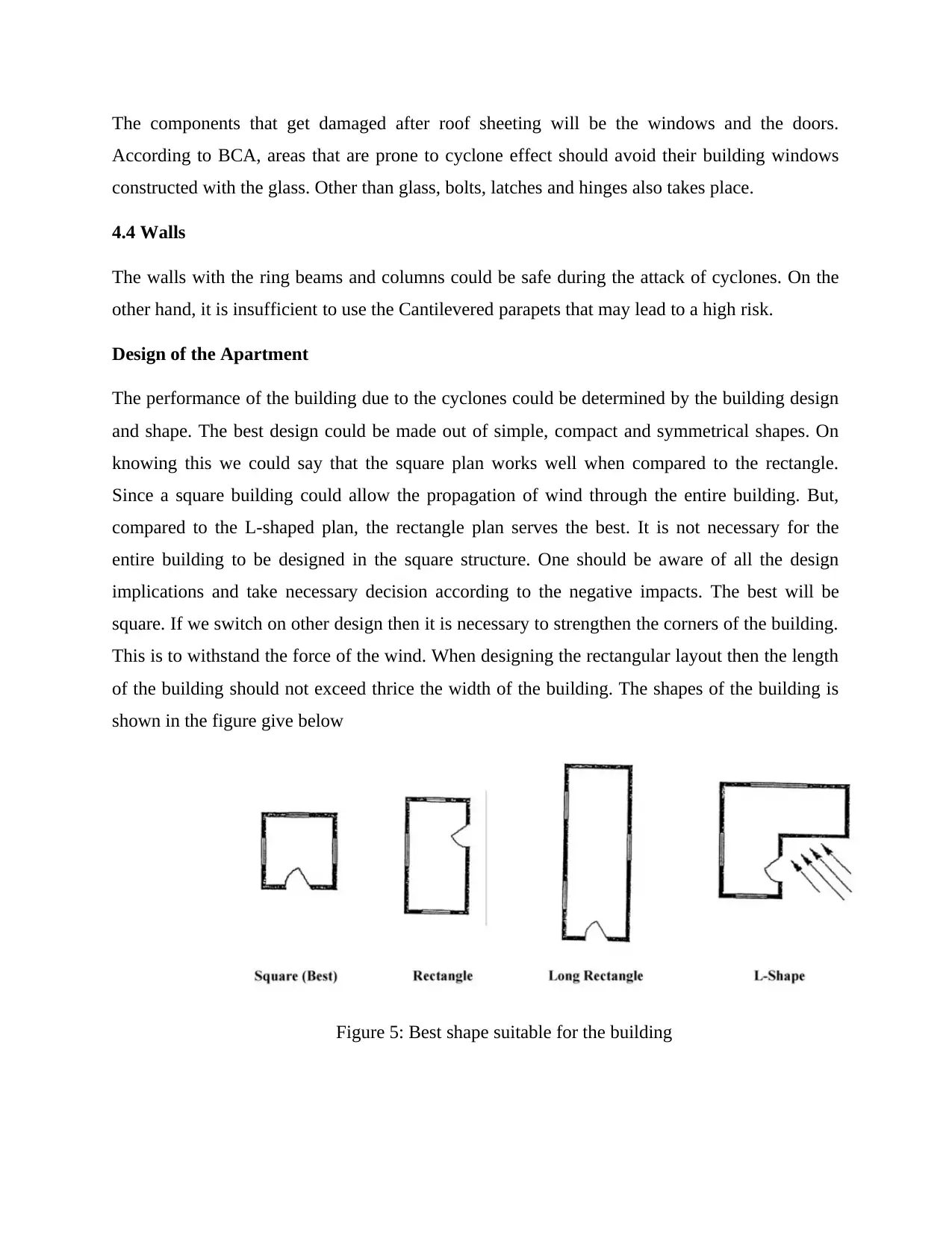
The components that get damaged after roof sheeting will be the windows and the doors.
According to BCA, areas that are prone to cyclone effect should avoid their building windows
constructed with the glass. Other than glass, bolts, latches and hinges also takes place.
4.4 Walls
The walls with the ring beams and columns could be safe during the attack of cyclones. On the
other hand, it is insufficient to use the Cantilevered parapets that may lead to a high risk.
Design of the Apartment
The performance of the building due to the cyclones could be determined by the building design
and shape. The best design could be made out of simple, compact and symmetrical shapes. On
knowing this we could say that the square plan works well when compared to the rectangle.
Since a square building could allow the propagation of wind through the entire building. But,
compared to the L-shaped plan, the rectangle plan serves the best. It is not necessary for the
entire building to be designed in the square structure. One should be aware of all the design
implications and take necessary decision according to the negative impacts. The best will be
square. If we switch on other design then it is necessary to strengthen the corners of the building.
This is to withstand the force of the wind. When designing the rectangular layout then the length
of the building should not exceed thrice the width of the building. The shapes of the building is
shown in the figure give below
Figure 5: Best shape suitable for the building
According to BCA, areas that are prone to cyclone effect should avoid their building windows
constructed with the glass. Other than glass, bolts, latches and hinges also takes place.
4.4 Walls
The walls with the ring beams and columns could be safe during the attack of cyclones. On the
other hand, it is insufficient to use the Cantilevered parapets that may lead to a high risk.
Design of the Apartment
The performance of the building due to the cyclones could be determined by the building design
and shape. The best design could be made out of simple, compact and symmetrical shapes. On
knowing this we could say that the square plan works well when compared to the rectangle.
Since a square building could allow the propagation of wind through the entire building. But,
compared to the L-shaped plan, the rectangle plan serves the best. It is not necessary for the
entire building to be designed in the square structure. One should be aware of all the design
implications and take necessary decision according to the negative impacts. The best will be
square. If we switch on other design then it is necessary to strengthen the corners of the building.
This is to withstand the force of the wind. When designing the rectangular layout then the length
of the building should not exceed thrice the width of the building. The shapes of the building is
shown in the figure give below
Figure 5: Best shape suitable for the building
Paraphrase This Document
Need a fresh take? Get an instant paraphrase of this document with our AI Paraphraser
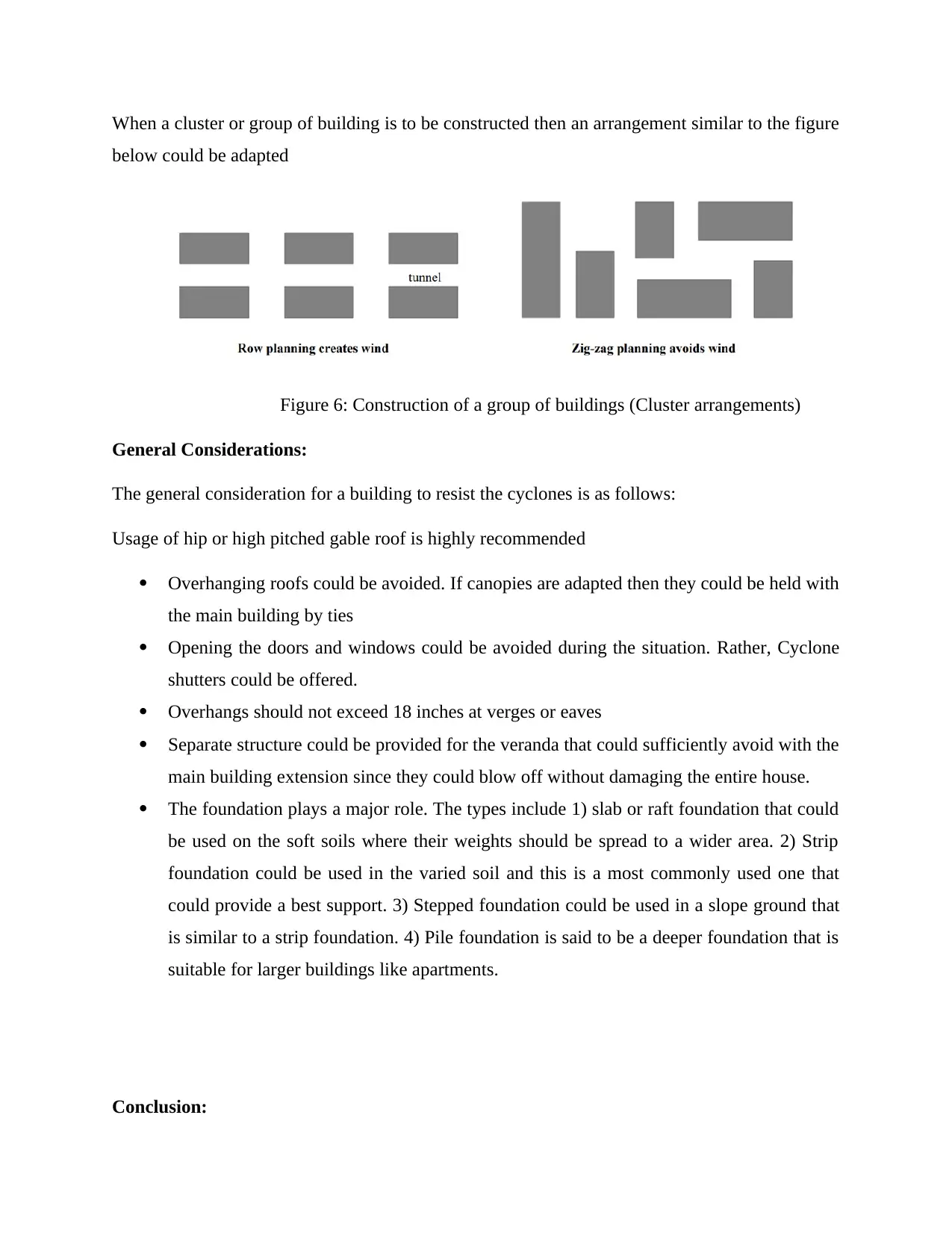
When a cluster or group of building is to be constructed then an arrangement similar to the figure
below could be adapted
Figure 6: Construction of a group of buildings (Cluster arrangements)
General Considerations:
The general consideration for a building to resist the cyclones is as follows:
Usage of hip or high pitched gable roof is highly recommended
Overhanging roofs could be avoided. If canopies are adapted then they could be held with
the main building by ties
Opening the doors and windows could be avoided during the situation. Rather, Cyclone
shutters could be offered.
Overhangs should not exceed 18 inches at verges or eaves
Separate structure could be provided for the veranda that could sufficiently avoid with the
main building extension since they could blow off without damaging the entire house.
The foundation plays a major role. The types include 1) slab or raft foundation that could
be used on the soft soils where their weights should be spread to a wider area. 2) Strip
foundation could be used in the varied soil and this is a most commonly used one that
could provide a best support. 3) Stepped foundation could be used in a slope ground that
is similar to a strip foundation. 4) Pile foundation is said to be a deeper foundation that is
suitable for larger buildings like apartments.
Conclusion:
below could be adapted
Figure 6: Construction of a group of buildings (Cluster arrangements)
General Considerations:
The general consideration for a building to resist the cyclones is as follows:
Usage of hip or high pitched gable roof is highly recommended
Overhanging roofs could be avoided. If canopies are adapted then they could be held with
the main building by ties
Opening the doors and windows could be avoided during the situation. Rather, Cyclone
shutters could be offered.
Overhangs should not exceed 18 inches at verges or eaves
Separate structure could be provided for the veranda that could sufficiently avoid with the
main building extension since they could blow off without damaging the entire house.
The foundation plays a major role. The types include 1) slab or raft foundation that could
be used on the soft soils where their weights should be spread to a wider area. 2) Strip
foundation could be used in the varied soil and this is a most commonly used one that
could provide a best support. 3) Stepped foundation could be used in a slope ground that
is similar to a strip foundation. 4) Pile foundation is said to be a deeper foundation that is
suitable for larger buildings like apartments.
Conclusion:
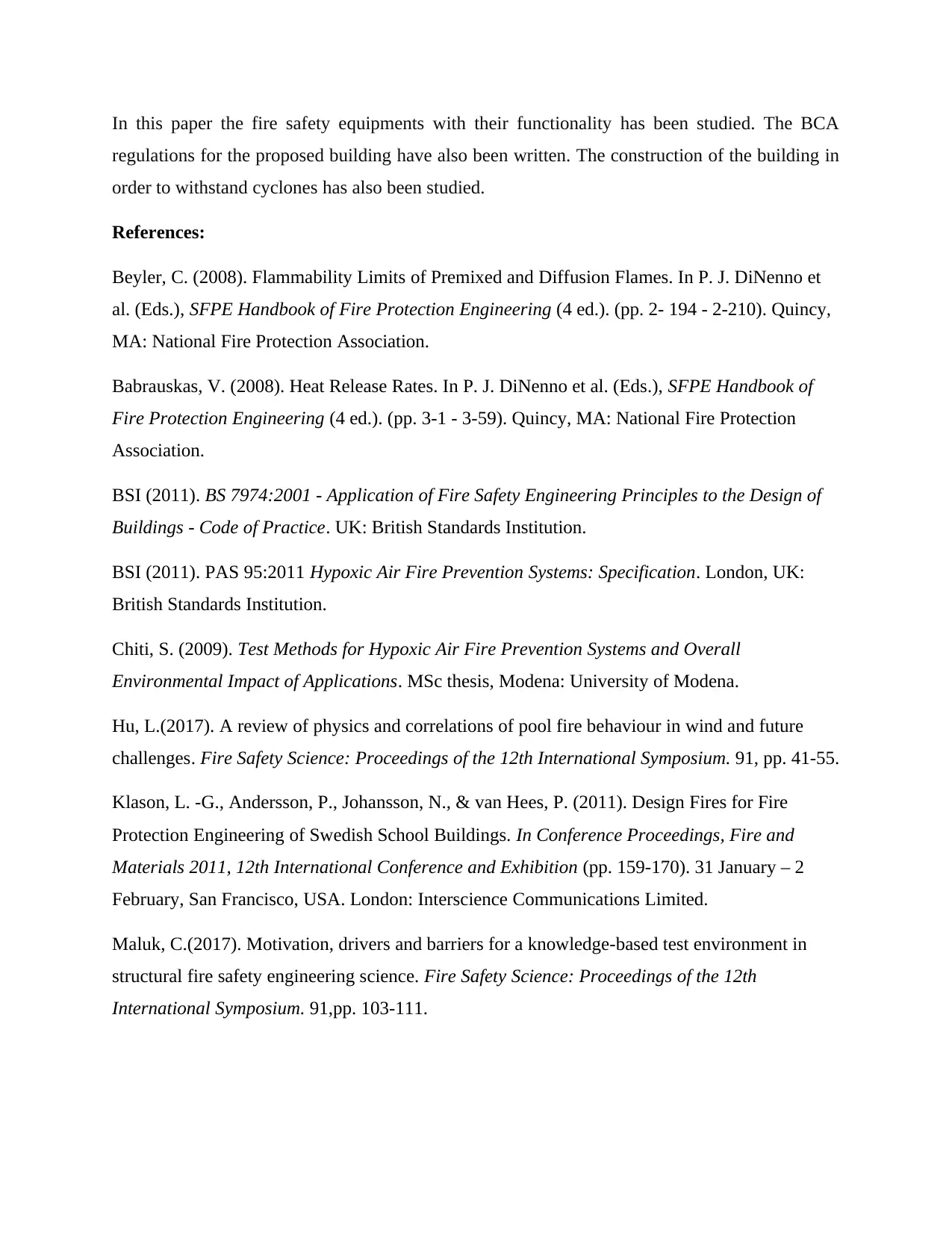
In this paper the fire safety equipments with their functionality has been studied. The BCA
regulations for the proposed building have also been written. The construction of the building in
order to withstand cyclones has also been studied.
References:
Beyler, C. (2008). Flammability Limits of Premixed and Diffusion Flames. In P. J. DiNenno et
al. (Eds.), SFPE Handbook of Fire Protection Engineering (4 ed.). (pp. 2- 194 - 2-210). Quincy,
MA: National Fire Protection Association.
Babrauskas, V. (2008). Heat Release Rates. In P. J. DiNenno et al. (Eds.), SFPE Handbook of
Fire Protection Engineering (4 ed.). (pp. 3-1 - 3-59). Quincy, MA: National Fire Protection
Association.
BSI (2011). BS 7974:2001 - Application of Fire Safety Engineering Principles to the Design of
Buildings - Code of Practice. UK: British Standards Institution.
BSI (2011). PAS 95:2011 Hypoxic Air Fire Prevention Systems: Specification. London, UK:
British Standards Institution.
Chiti, S. (2009). Test Methods for Hypoxic Air Fire Prevention Systems and Overall
Environmental Impact of Applications. MSc thesis, Modena: University of Modena.
Hu, L.(2017). A review of physics and correlations of pool fire behaviour in wind and future
challenges. Fire Safety Science: Proceedings of the 12th International Symposium. 91, pp. 41-55.
Klason, L. -G., Andersson, P., Johansson, N., & van Hees, P. (2011). Design Fires for Fire
Protection Engineering of Swedish School Buildings. In Conference Proceedings, Fire and
Materials 2011, 12th International Conference and Exhibition (pp. 159-170). 31 January – 2
February, San Francisco, USA. London: Interscience Communications Limited.
Maluk, C.(2017). Motivation, drivers and barriers for a knowledge-based test environment in
structural fire safety engineering science. Fire Safety Science: Proceedings of the 12th
International Symposium. 91,pp. 103-111.
regulations for the proposed building have also been written. The construction of the building in
order to withstand cyclones has also been studied.
References:
Beyler, C. (2008). Flammability Limits of Premixed and Diffusion Flames. In P. J. DiNenno et
al. (Eds.), SFPE Handbook of Fire Protection Engineering (4 ed.). (pp. 2- 194 - 2-210). Quincy,
MA: National Fire Protection Association.
Babrauskas, V. (2008). Heat Release Rates. In P. J. DiNenno et al. (Eds.), SFPE Handbook of
Fire Protection Engineering (4 ed.). (pp. 3-1 - 3-59). Quincy, MA: National Fire Protection
Association.
BSI (2011). BS 7974:2001 - Application of Fire Safety Engineering Principles to the Design of
Buildings - Code of Practice. UK: British Standards Institution.
BSI (2011). PAS 95:2011 Hypoxic Air Fire Prevention Systems: Specification. London, UK:
British Standards Institution.
Chiti, S. (2009). Test Methods for Hypoxic Air Fire Prevention Systems and Overall
Environmental Impact of Applications. MSc thesis, Modena: University of Modena.
Hu, L.(2017). A review of physics and correlations of pool fire behaviour in wind and future
challenges. Fire Safety Science: Proceedings of the 12th International Symposium. 91, pp. 41-55.
Klason, L. -G., Andersson, P., Johansson, N., & van Hees, P. (2011). Design Fires for Fire
Protection Engineering of Swedish School Buildings. In Conference Proceedings, Fire and
Materials 2011, 12th International Conference and Exhibition (pp. 159-170). 31 January – 2
February, San Francisco, USA. London: Interscience Communications Limited.
Maluk, C.(2017). Motivation, drivers and barriers for a knowledge-based test environment in
structural fire safety engineering science. Fire Safety Science: Proceedings of the 12th
International Symposium. 91,pp. 103-111.
⊘ This is a preview!⊘
Do you want full access?
Subscribe today to unlock all pages.

Trusted by 1+ million students worldwide
1 out of 13
Related Documents
Your All-in-One AI-Powered Toolkit for Academic Success.
+13062052269
info@desklib.com
Available 24*7 on WhatsApp / Email
![[object Object]](/_next/static/media/star-bottom.7253800d.svg)
Unlock your academic potential
Copyright © 2020–2025 A2Z Services. All Rights Reserved. Developed and managed by ZUCOL.





